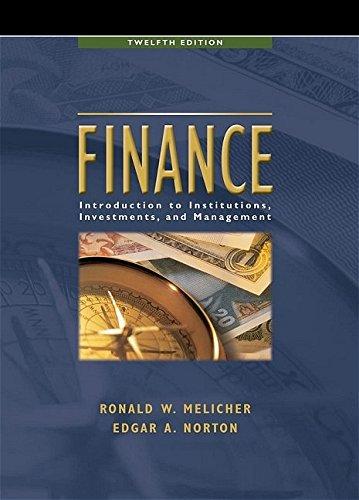Question
1. An American Hedge Fund is considering a one-year investment in an Italian government bond with a one-year maturity and a euro-denominated rate of return
1.
An American Hedge Fund is considering a one-year investment in an Italian government bond with a one-year maturity and a euro-denominated rate of return of i = 5%. The bond costs 1,000 today and will return 1,050 at the end of one year without risk. The current exchange rate is 1.00 = $1.50. U.S. dollar-denominated government bonds currently have a yield to maturity of 4 percent. Suppose that the European Central Bank is considering either tightening or loosening its monetary policy. It is widely believed that in one year there are only two possibilities:
S1 ($/) = 1.80 per
S1 ($/) = 1.40 per
Following revaluation, the exchange rate is expected to remain steady for at least another year.
Your banker quotes the euro-zone risk-free rate at i = 5% and the U.S. risk free rate at i$ = 4%. What is the value of the option?
Select one:
a. $16.54
b. $80.55
c. $76.54
d. $86.54
e. $66.55
2.
The adjusted present value (APV) model that is suitable for an MNC is the basic net present value (NPV) model not expanded to
Select one:
a. discern the blocking of certain cash flows by the host country from being legally remitted to the parent.
b. consider foreign currency fluctuations or extra taxes imposed by the host country on foreign exchange remittances.
c. distinguish between the market value of a levered firm and the market value of an unlevered firm.
d. the market value of a levered firm and unlevered firm remains the same.
3.
. Export-Import Bank (Ex-Im bank) is an independent agency of the United States government that facilitates and finances U.S. export trade. Ex-Im bank's purpose is to provide financing in situations where private financial institutions are unable or unwilling to because of which of the following reasons:
(i) The loan maturity is too long.
(ii) The amount of the loan is too large.
(iii) The loan risk is too great.
(iv) The importing firm has difficulty obtaining hard currency for payment.
(v) There are no futures or forward contracts available for foreign exchange transactions.
Select one:
a. (i), (ii), (iii), (iv), and (v)
b. (i), (ii), (iii), and (iv)
c. (i) and (ii)
d. (i), (ii) and (iii)
e. Only (i)
4.
So-called subprime mortgages were typically
Select one:
a. not held by the originating bank, but instead were resold for packaging into mortgage-backed securities. Additionally, they were aggregated and then sliced into tranches each representing a different risk class: AAA, AA-BB, or unrated.
b. aggregated and then sliced into tranches each representing only unrated risk class.
c. not held by the originating bank, but rather aggregated to be resold on the share market.
d. not held by the originating bank, but instead were resold for packaging into mortgage-backed securities. Additionally, they were aggregated and then sliced into tranches each representing only unrated risk class.
e. held by the originating bank, and were resold for packaging into mortgage-backed securities.
Step by Step Solution
There are 3 Steps involved in it
Step: 1

Get Instant Access to Expert-Tailored Solutions
See step-by-step solutions with expert insights and AI powered tools for academic success
Step: 2

Step: 3

Ace Your Homework with AI
Get the answers you need in no time with our AI-driven, step-by-step assistance
Get Started


